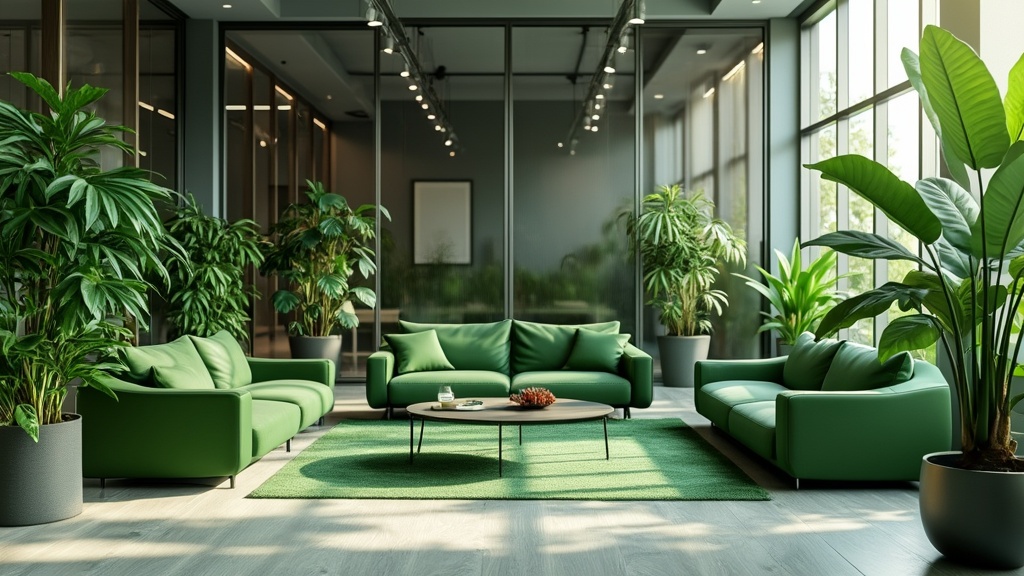The rise of eco-conscious living has prompted green furniture brands to transform modern aesthetics in remarkable ways. These brands prioritize not only sustainability but also the reimagining of design in our homes.
With a focus on environmentally friendly options, consumers now discover exceptional styles that seamlessly blend beauty with responsibility.
By embracing innovative materials and ethical practices, these brands demonstrate that selecting sustainable furniture can significantly enhance the ambiance of living spaces.
Click here to learn more about: interior designers and decorators
Sustainable Furniture Options For Every Home
Exploring sustainable materials such as bamboo, reclaimed wood, and recycled metals reveals their crucial role in reducing environmental impact.
Utilizing these materials contributes to a circular economy that fosters resource conservation and minimizes waste. Certifications like FSC certified and GreenGuard provide essential assurance for consumers seeking ecofriendly furniture choices.
These ecolabels effectively clarify sustainability claims, empowering informed purchasing decisions.
Importance of Certifications
Recognizing the significance of certifications can facilitate purchasing choices for eco-conscious consumers. These certifications ensure that products meet stringent environmental standards and promote transparency in sourcing and manufacturing practices.
Identifying Sustainable Brands
To successfully identify sustainable furniture brands, look for the following criteria:.
- Transparency regarding sourcing and materials used.
- Commitment to ethical manufacturing and craftsmanship.
- Focus on community support and local artisans.
Choosing sustainable design encompasses enhancing both indoor air quality and overall wellness in living spaces.
By embracing these guidelines, consumers can confidently navigate the world of furniture sustainability, making choices that reflect their commitment to an eco-friendly home. As awareness of environmental issues grows, the demand for innovative materials and responsible consumption will only increase.

How Do Ecofriendly Home Decor Choices Impact Health
Ecofriendly home decor choices can play a significant role in promoting a healthier living environment. Natural materials, such as wood and bamboo, have the ability to enhance indoor air quality by absorbing harmful pollutants that often accumulate indoors.
Utilizing low-VOC finishes is essential; they reduce the emission of toxic substances from synthetic materials, which can lead to serious health concerns.
These synthetic alternatives frequently contain chemicals that have been linked to various health issues, including respiratory problems and allergies.
To further improve wellness at home, consider integrating plants into your decor. Species such as snake plants and peace lilies are renowned for their air-purifying abilities.
Strategically placing them throughout living spaces can maximize their health benefits, ultimately fostering a more refreshing atmosphere.
Benefits Of Upcycled Furniture In Design
Embracing upcycled furniture brings creativity into home decor while promoting substantial waste reduction. Upcycled furniture often highlights innovative uses of materials like reclaimed wood, resulting in unique, functional pieces that contribute to a sustainable home.
Examples of successful transformations include:.
- Tables crafted from salvaged barn doors
- Benches designed from vintage suitcases
To discover upcycled treasures, explore local flea markets or thrift stores. These locations often offer a wide variety of unique pieces waiting to be revitalized. Participating in community workshops can also provide hands-on experience, inspiring personal design projects that champion responsible consumption and enrich a culture of sustainability. This approach not only reduces waste but also supports local artisans and enhances community bonds, making your living space a reflection of ethical practices and creativity.
Ecofriendly Home Decor
- Natural materials like wood and bamboo can absorb indoor pollutants, improving air quality.
- Low-VOC finishes significantly reduce toxic emissions from synthetic materials, lowering health risks.
- Plants such as snake plants and peace lilies are effective in purifying indoor air.
- Upcycled furniture reduces waste and promotes sustainability through innovative reuse of materials.
Understanding Organic Upholstery Materials
Organic upholstery not only enhances indoor air quality but also promotes a healthier living environment. Organic textiles, cultivated without harmful pesticides or synthetic fertilizers, contribute to environmental awareness and sustainable practices.
Choosing organic upholstery can significantly reduce allergens that commonly arise from conventional fabrics, making it a smart choice for those focused on wellness-oriented furniture.
Investing in organic upholstery aligns with trends in sustainable furniture, showcasing a commitment to responsible home decor.
Benefits for Health and Environment
The health benefits of choosing organic materials extend beyond mere aesthetics.
Organic textiles foster improved indoor air quality by minimizing exposure to volatile organic compounds (VOCs) often found in synthetic fabrics. This choice supports both personal well-being and ecological sustainability, promoting a conscious consumerism approach that prioritizes environmentally friendly materials.
Organic upholstery contributes to the circular economy by supporting ethical sourcing and fair trade practices.
Caring for Organic Upholstery
To maximize the lifespan of organic upholstery, regular maintenance is essential. Vacuuming on a weekly basis helps in preventing dust buildup, while employing gentle, natural cleaning products ensures the fabric remains undamaged.
Responsible consumption practices like these will not only preserve the beauty of your upholstery but also enhance its durability, showcasing commitment to furniture longevity.
The Beauty Of Reclaimed Wood Furniture
The uniqueness of reclaimed wood furniture captivates with its blend of history and craftsmanship.
Each piece tells a distinct story through its varied color and texture, appealing to those who appreciate sustainable design.
Choosing reclaimed wood furniture is an environmentally responsible choice that effectively reduces waste; repurposing old timber conserves resources and minimizes landfill contributions, significantly aiding in waste reduction.
Aesthetic Appeal and Uniqueness
Beyond its sustainability, reclaimed wood adds character to any eco-friendly home decor. The inherent imperfections of reclaimed materials bring warmth and individuality to interiors, confirming the trend towards minimalist design that values quality craftsmanship over uniformity.
As a result, reclaimed wood furniture becomes a focal point in a room, highlighting ecological consciousness in contemporary settings.
Maintaining Reclaimed Wood Quality
To ensure the lasting beauty of reclaimed wood, careful maintenance is paramount. Avoiding direct sunlight prevents fading and preserves the rich hues of the wood.
Regularly applying natural oils nourishes and protects the surface, sustaining its stunning appearance.
This commitment to design for durability supports the philosophy of furniture sustainability, allowing these pieces to remain treasured for generations.
Organic Upholstery and Reclaimed Wood Furniture
- Organic upholstery can reduce indoor allergens by up to 30%, improving overall health for occupants.
- Using reclaimed wood furniture can save an estimated 5 billion pounds of wood from landfills each year.
- Natural cleaning products used on organic upholstery can minimize harmful chemical exposure, benefiting both health and the environment.
- Reclaimed wood furniture often features unique designs, with no two pieces being exactly alike, enhancing aesthetic appeal.
Why Choose Bamboo Furniture For Sustainability
Selecting bamboo furniture significantly enhances your commitment to sustainability. Bamboo, a unique grass species, can grow up to 91 cm (35 inches) in just one day.
This rapid growth rate ensures that bamboo can be harvested sustainably without harming its ecosystem.
Bamboo has remarkable ecofriendly properties; it absorbs carbon dioxide and produces 35% more oxygen than traditional trees, making it a champion for a healthier environment.
Bamboo’s natural durability rivals that of steel, resulting in durable furniture that can last for decades.
When styling bamboo furniture, consider placing it in contemporary settings where natural textures thrive. Mixing it with other organic materials like jute and cotton creates a cohesive and inviting ecofriendly home decor.
Importance Of Nontoxic Finishes In Furniture
Selecting furniture with nontoxic finishes directly impacts indoor air quality and health.
Conventional finishes often release volatile organic compounds (VOCs), which can lead to health issues, including headaches and respiratory problems. These harmful substances undermine the benefits of sustainable materials like bamboo, rendering their eco-friendly attributes less effective.
Effect on Indoor Air Quality
Indoor air quality can be significantly affected by the type of finishes applied to furniture.
Low VOCs are essential for promoting a healthy space.
Choosing furniture sustainability starts with understanding how finishes contribute to environmental awareness and personal well-being.
Choosing Nontoxic Finishes
When selecting furniture, prioritize those labeled as low VOC or featuring natural finishes.
Research brands that emphasize ethical manufacturing and strive to produce environmentally friendly products. Choosing nontoxic finishes not only enhances the longevity of your furniture but also contributes positively to indoor air quality.
Bamboo Furniture and Nontoxic Finishes
- Bamboo can grow up to 91 cm (35 inches) in a single day, making it one of the fastest-growing plants on Earth.
- Bamboo produces 35% more oxygen than traditional trees, contributing positively to air quality.
- Low VOC finishes help improve indoor air quality and reduce health risks associated with conventional finishes.
- Choosing nontoxic finishes supports ethical manufacturing practices and promotes environmental sustainability.
Exploring Fair Trade Practices In Furniture Production
Fair trade practices in furniture production play a significant role in enhancing the livelihoods of local artisans, contributing to ethical sourcing and sustainable design. Purchasing eco-friendly furniture allows consumers to directly support fair wages and safe working environments for craftsmen.
This approach not only fosters community support but also leads to improved education and healthcare access through artisan cooperatives.
Recognizing the value of craftsmanship enables buyers to appreciate the unique stories behind each piece.
The Impact of Fair Trade on Artisans
Through fair trade practices, artisans engage in a circular economy that promotes sustainable furniture production.
By providing local artisans with access to markets, they can thrive while preserving traditional techniques. This socially responsible business model empowers communities, leading to enhanced economic stability and growth.
As a result, artisans not only gain financial independence but also contribute to resource conservation and environmental awareness.
Identifying Fair Trade Certifications
To identify fair trade furniture, consumers should look for prominent labels such as Fair Trade Certified or endorsements from the World Fair Organization. These green certifications ensure that the product meets strict ethical standards while promoting transparency in production processes.
Awareness of these certifications empowers consumers to make responsible choices that align with their values, contributing to a more equitable global marketplace.
Being informed about ecolabels can help recognize furniture that adheres to sustainable practices, further supporting the movement towards responsible consumption.
Fair Trade in Furniture Production
- Fair trade practices help artisans earn fair wages, improving their quality of life and economic stability.
- Artisan cooperatives enhance access to education and healthcare for community members.
- Fair trade furniture often incorporates traditional techniques, preserving cultural heritage and craftsmanship.
- Recognizing fair trade certifications promotes transparency and ethical sourcing in the furniture industry.
Furniture Recycling Ideas That Inspire
Biodegradable Furniture Materials Inspire Sustainable Living



